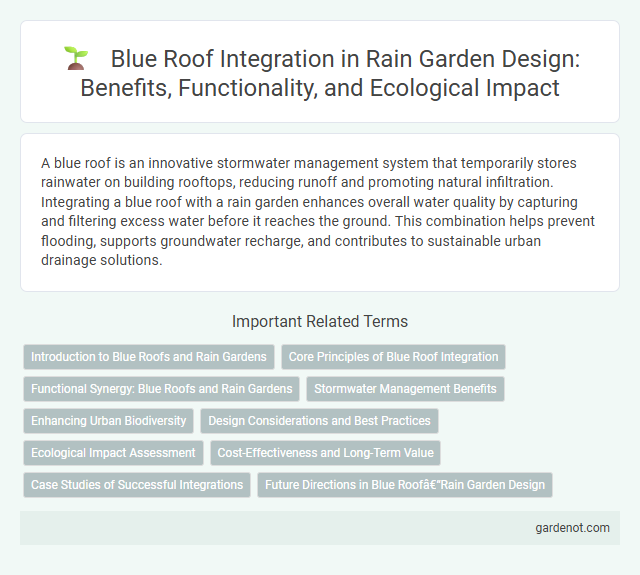A blue roof is an innovative stormwater management system that temporarily stores rainwater on building rooftops, reducing runoff and promoting natural infiltration. Integrating a blue roof with a rain garden enhances overall water quality by capturing and filtering excess water before it reaches the ground. This combination helps prevent flooding, supports groundwater recharge, and contributes to sustainable urban drainage solutions.
Introduction to Blue Roofs and Rain Gardens
Blue roofs temporarily store stormwater on rooftops, reducing runoff and alleviating urban flooding, while rain gardens absorb and filter this collected water through vegetation and soil layers. Integrating blue roofs with rain gardens enhances sustainable stormwater management by combining retention and natural infiltration processes. This synergy improves water quality, mitigates peak flow rates, and supports urban ecosystem health.
Core Principles of Blue Roof Integration
Blue roof integration relies on core principles including controlled stormwater detention, which slows runoff to reduce downstream flooding and erosion, and enhanced water quality through sediment and pollutant settling. Incorporating porous surfaces and drainage systems allows temporary water storage on rooftops, promoting infiltration and evapotranspiration. Effective blue roof design also prioritizes structural load capacity and maintenance accessibility to ensure long-term functionality and durability.
Functional Synergy: Blue Roofs and Rain Gardens
Blue roofs and rain gardens work together to enhance urban stormwater management by maximizing water retention and reducing runoff volume. While blue roofs temporarily store rainwater on rooftop surfaces, rain gardens capture and infiltrate this runoff at ground level, promoting groundwater recharge. This functional synergy improves flood mitigation, water quality, and urban resilience against heavy precipitation events.
Stormwater Management Benefits
Blue roofs significantly enhance stormwater management by temporarily storing rainwater on rooftop surfaces, reducing peak flow rates and mitigating urban flooding risks. They work in tandem with rain gardens by slowing down runoff, allowing more effective infiltration and pollutant removal in downstream green infrastructure. Implementing blue roofs alongside rain gardens improves overall watershed health, promotes groundwater recharge, and decreases strain on municipal sewer systems.
Enhancing Urban Biodiversity
Blue roofs complement rain gardens by temporarily retaining stormwater, reducing runoff volume and peak flow in urban areas. Integrating blue roofs with rain gardens creates diverse habitats for native plants and pollinators, enhancing urban biodiversity. This combined approach supports ecological resilience and improves water quality by facilitating natural filtration processes.
Design Considerations and Best Practices
Blue roof design considerations prioritize controlled stormwater detention to reduce runoff velocity and volume, incorporating structural support to accommodate water weight safely. Best practices include integrating overflow mechanisms to prevent water accumulation beyond capacity, using waterproof membranes, and selecting vegetation that tolerates periodic saturation. Proper slope grading and regular maintenance ensure functionality and prolong the roof's lifespan while enhancing urban stormwater management.
Ecological Impact Assessment
Blue roofs reduce stormwater runoff by temporarily storing rainwater on rooftops, mitigating urban flooding and easing pressure on sewer systems. The ecological impact assessment of blue roofs highlights their role in enhancing water quality by filtering pollutants before water is released into natural water bodies. Implementation of blue roofs contributes to improved urban biodiversity, supporting microorganisms and plant life that thrive in moist environments.
Cost-Effectiveness and Long-Term Value
A blue roof offers cost-effective stormwater management by temporarily storing rainwater, reducing peak runoff and mitigating flood risks. Its installation and maintenance costs are lower compared to traditional green infrastructure, providing substantial long-term value through decreased water treatment expenses and infrastructure wear. Enhanced durability and integration with existing roof systems further optimize lifecycle savings and environmental benefits.
Case Studies of Successful Integrations
Blue roof technology has been effectively integrated with rain gardens in urban environments to enhance stormwater management by temporarily storing runoff and slowly releasing it into green infrastructure. Case studies from cities like Philadelphia demonstrate that combining blue roofs with rain gardens reduces peak flow rates, improves water quality, and mitigates flooding risks. These successful implementations highlight the synergistic benefits of coupling blue roofs and rain gardens for sustainable urban water management.
Future Directions in Blue Roof–Rain Garden Design
Future directions in blue roof-rain garden design emphasize integrating advanced filtration media and smart water flow control systems to enhance stormwater retention and improve water quality management. Research explores modular, scalable designs combining green infrastructure principles with IoT sensors for real-time monitoring and adaptive response to rainfall events. Innovations prioritize maximizing runoff reduction, supporting urban biodiversity, and optimizing maintenance efficiency in diverse climates.
Blue roof Infographic

 gardenot.com
gardenot.com